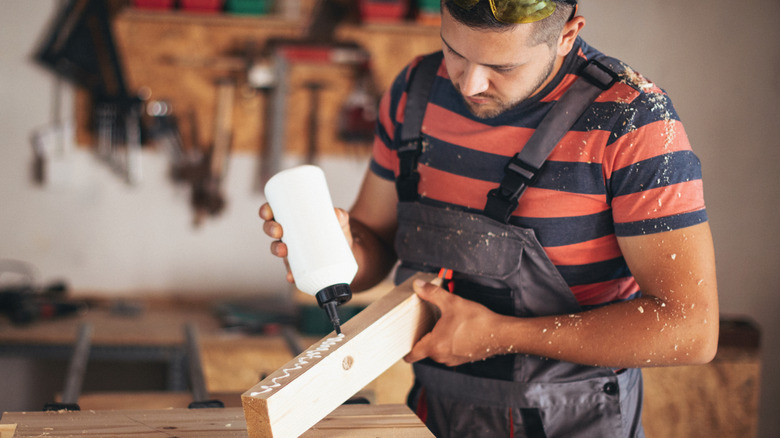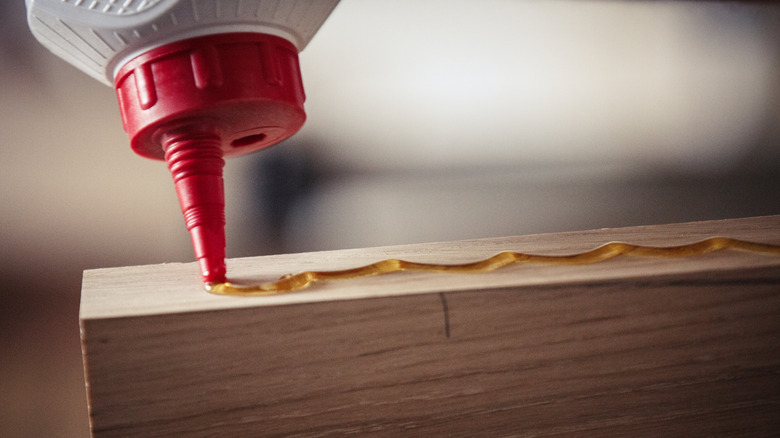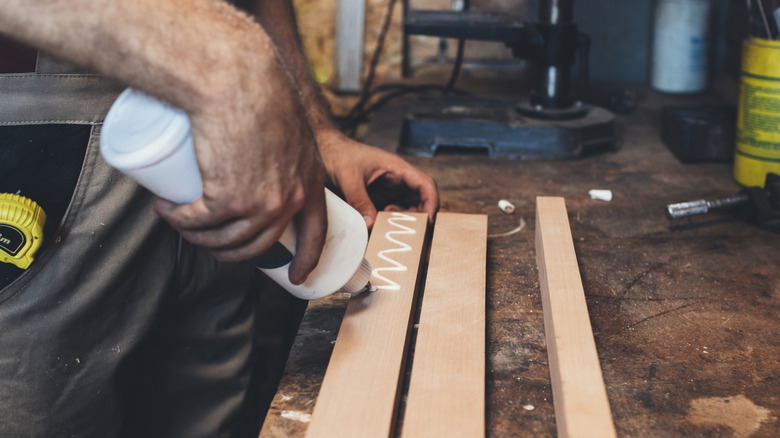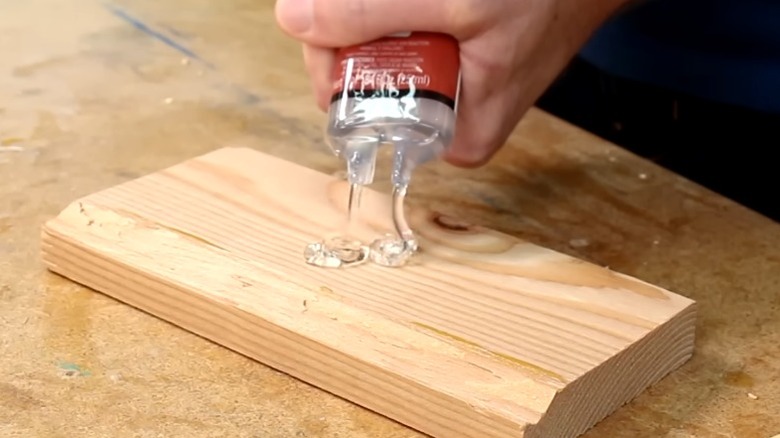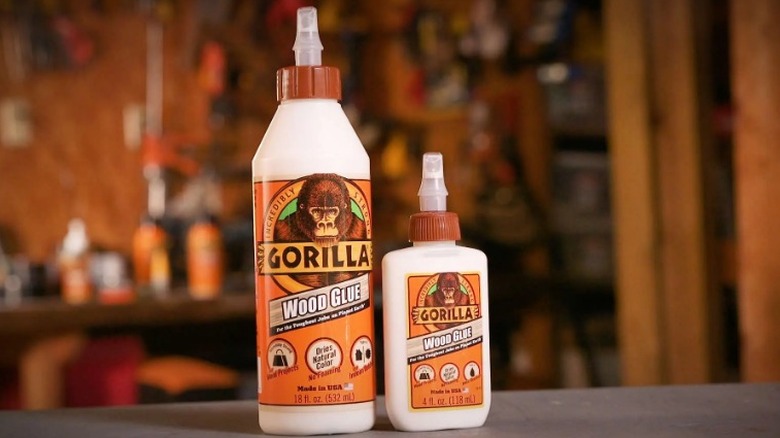This Is The Strongest Wood Glue For Your Woodworking Projects
Nails, screws, and other fasteners all have their place in the woodshop, but nothing holds pieces together quite so seamlessly as glue. Not only is wood glue cheap and easy to work with, but when properly adhered and set with adequate pressure, the bond between two glued pieces can actually be stronger than the wood itself. So it's no surprise that many carpenters consider it to be a woodworking staple that's worth investing in.
That said, there are a lot of different kinds of glue out there, and not all of them have this kind of bonding strength. Cyanoacrylate adhesives such as Super Glue are useful for quick, supplementary bonds (side note: they're also great for fixing a cracked windshield.) These are usually thin, so they generally aren't great for filling gaps and only create surface-level bonds that don't have a ton of holding power, but they dry quickly and can often be used to attach small decorative pieces or hold pieces together long enough for you to attach other fasteners or wait for stronger adhesives to cure. Epoxy resin can be useful when attaching non-wooden components like metal or plastic to wood, but it can be brittle. Liquid plastic weld can powerfully attach small pieces, and contact cement is great for applying veneer. But which type of glue is the strongest when it comes to bonding two types of wood together?
The trouble with choosing the strongest wood glue
There are a few caveats to choosing the strongest wood glue. The first is that "wood" isn't a uniform substance. The density of the grain and the smoothness of the surface can vary across different species and even across different boards composed of the same type of wood. Different adhesives will be able to form bonds of varying strength depending on the texture, grain, and available surface area of the wood, as well as certain environmental factors like humidity and temperature.
The second is that "strength" isn't always best measured in pure holding power. If you want to get really technical, Delo Monopox is widely touted as the strongest adhesive in the world. The company that manufactures it famously used just 3 grams of the adhesive to lift a 16.3-ton truck in 2013 — and it can be used on wood. That said, it isn't marketed as a "wood glue," and the vast majority of people wouldn't use it that way. Likewise, other epoxies technically have a higher bonding strength than glues that are marketed as wood glues, but the cured resin can be brittle along longer joints and will break before it bends, making it effectively weaker in certain use cases. That's not even mentioning its other pitfalls. It's fumey, toxic, messy, difficult to sand, and it takes an incredibly long time to cure, even in the best conditions.
The biggest issue is that, at a certain point, bonding strength ceases to matter. In the case of both PVA and epoxy, the wood will break before the glue does, meaning that the strength of the fibers in the wood itself dictates the breaking point of the joint.
PVA is the strongest wood glue for most practical woodworking applications
Polyvinyl acetate, AKA PVA glue, is the adhesive that is most often marketed as wood glue, and it's the substance most woodworkers think of when the subject is brought up. This product is incredibly popular for a number of reasons. It's affordable, which is nice because large-scale glue-ups can often require several ounces of adhesive. It's fairly safe to use as it's non-toxic and doesn't put off heavy fumes like epoxy. It's also perfectly safe to get on your skin. Many carpenters spread the glue with their bare fingers, and peeling the residue off your skin is oddly satisfying. Many versions of the glue are also either water-resistant or completely waterproof, meaning that rain, spills, and ambient moisture won't break down the bonds. But the main quality is its bonding strength. According to the Architectural Woodwork Institute, "Within the woodworking community, many regard Polyvinyl Acetate (PVA) glue as the strongest glue for wood," though they note that it isn't always ideal for all weather conditions. It is, however, able to flex, giving more room for the wood's natural expansion and contraction while also not snapping when the wood is forced to bend under pressure.
There are a couple of different kinds of PVA out there, though. White PVA is what is sometimes called school glue. This is the primary product sold by the brand Elmer's and doesn't have a tremendous amount of holding power when used on wood. Yellow PVA (also called carpenter's glue), on the other hand, is significantly stronger, offering a more powerful bond and greater water resistance. This is the PVA that most woodworkers use. The reason yellow PVA is so strong is because it's able to seep into the fibers of the wood, filling all of the tiny gaps and spaces and getting a stronger hold on the material as it cures.
When PVA isn't the strongest
So we've established that PVA is an incredibly strong and versatile glue, but that doesn't mean that it's the best for every situation. There are a few specific instances where you might be better off using different kinds of adhesive.
The first is any time you're gluing wood to something that isn't wood. PVA glue doesn't adhere well to plastics, rubber, hides, metal, fabrics, or other materials. Cyanoacrylate, epoxy, Weldbond, and even hot glue can work much better for this.
The second has to do with temperature. PVA can break down when it's exposed to extreme cold or extreme heat, making epoxy resin a stronger choice for outdoor furniture in areas exposed to extreme weather. PVAs that aren't completely waterproof may also struggle to maintain their bonds in areas exposed to a high amount of moisture or humidity.
The final instance has to do with wood grain. PVA glues work great on board faces but don't work very well on end grain. This is because too much of the glue will seep between the fibers as it cures, and there won't be enough remaining residue for the joint to get a good hold. There is a trick where you can pack PVA glue into the endgrain and then allow it to dry before re-gluing it to the joint in order to get a stronger joint. Even then, the joint won't be as good, however, and epoxy may work better in these situations.
There are a lot of good PVA brands out there, but Gorilla comes out on top
There are several brands of PVA wood glue out there. The ratio of polyvinyl acetate polymer, water, plasticizers, and stabilizers is slightly different across different brands, but the general chemical composition is fairly similar. YouTuber Matthias Wandal tested the torsional shear strength of several brands, and he found that Gorilla Wood Glue was the strongest, followed closely by Weldbond and Titebond 3. Bob Villa also tested several popular glues and came to a similar conclusion, listing Gorilla Wood Glue as the best overall. Ben of Lion & Bear Woodworking likewise placed Gorilla ahead of Titebond, but it's worth noting that the wood failed before the glue in both tests.
Gorilla Wood Glue is a PVA that is suitable for indoor and outdoor use. It dries a natural tan color rather than the yellow or brown you get with many other glues, and the company claims that it only requires 20-30 minutes of clamp time. It passes ANSI/HPVA Type II water resistance and doesn't expand as it cures like regular Gorilla Glue.
Titebond has three wood glue formulas. Titebond Original is an aliphatic resin, which is a type of PVA, that's designed specifically for interior use and has a 3,600 psi bond strength. Titebond 2 Premium is a PVA that has a slightly stronger 3,750 psi bond strength and is considered water resistant or "weatherproof." Then there is Titebond 3 Ultimate, which is yet another PVA glue with 4,000 psi bond strength. It's also considered fully waterproof. Any of these will work, but Titebond 3 is technically the strongest.
